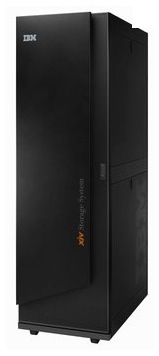This article is more than 1 year old
XIV gets Infiniband and boosted CPUs
September release date for third-generation box
IBM has boosted the processors in its third generation XIV array and added InfiniBand for internal communications to make it go faster.
There can be from 6 to 15 data modules (enclosures) in an XIV array, each containing 12 of the 7,200rpm, 1 or 2TB SAS drives. Each module has its own multi-core processing resource, differentiating the XIV from traditional dual controller arrays such as EMC's VNX or NetApp's FAS products. The linked modules provide what IBM calls a massively parallel, grid storage architecture.
CPUs and comms
The gen 2 XIV catered for a maximum of 84 CPU cores, which came with 8 or 16GB of RAM per data module and up to 240 Gbit/s of cache-to-disk bandwidth. There was one quad-core CPU per module plus three more in the entry-level 6 module configuration and six more in the 7 to 15 module configurations, which were used in the inter-module communications area. The gen 3 XIV drops these extra CPUs.

The gen 3 XIV can have up to 60 hyper-threaded, quad-core CPUs, with a single CPU and 24GB of memory per module, 360GB in total. The cache-to-disk bandwidth number has doubled to 480Gbit/s.
The third generation XIV model 114 array supports up to 180 2TB SAS drives in a single frame, as before – which, due to mirroring, means a maximum of 161TB of usable storage. The gen 2 XIV 1TB disk option as been dropped.
Gen 2 XIV supported 24 x 4Gbit/s Fibre Channel (FC) ports and 6 x iSCSI 1GbitE ports. Now there can be up to 22 x 1GbitE iSCSI ports or 24 x 8Gbit/s Fibre Channel ports for host connectivity. Dual 20Gbit/s InfiniBand links are used for inter-module communications instead of Ethernet as before.
XIV software
XIV system software v11.0 includes synchronous and asynchronous remote mirroring; thin provisioning; data migration; quality of service controls; LDAP authentication support; VMware VAAI support; and differential, writeable snapshots.
One aspect of the XIV idea is to use fat and medium speed drives, 2TB SAS jobs, and get needed I/O speed from multiple spindles and striped data. An XIV datasheet (12-page PDF/747KB) states: "The system stores data by breaking it down into 1 megabyte chunks called partitions, each mirrored for redundancy to another module. The system distributes all the partitions automatically and uniformly across all the disks by means of a sophisticated pseudo-random distribution algorithm."
This means there is no need for tiering software to move data between different tiers of storage as its activity level changes; XIV provides a flat storage space.
In these days of flash caches, that is not enough, and IBM will add support for up to 7.5TB of flash memory in the first half of 2012. The company says this will reduce random read I/O latency by up to 90 per cent. The flash will not be configured as a higher-performance tier of storage but as a cache.
Potential roadmap
The strength of the XIV is its single disk type and parallel, mirrored, grid architecture. The limitation of the XIV is exactly that. Adding a separate solid state drive (SSD) storage tier would require deep-rooted code changes. Adding heterogeneous disk types in the same array or modules would require equally substantial changes. XIV has been built from identical storage Lego blocks and the simplest way to make it even more powerful and capable than this gen 3 model, would be to uprate InfiniBand to QDR, 40Gbit/s, uprate the module processors again – to Sandy Bridge, say – bring in 3TB drives, and increase the module count.
A 30-module XIV with 3TB drives would provide about 480TB of usable storage. If IBM wanted to persist in minimising competitive overlap with the DS8000 range then it could move to 2.5-inch drives and have more of them in the data modules than the 12 x 3.5-inch drives. A module could hold 24 x 2.5-inch 1TB drives: a capacity level likely to emerge by the middle of next year. This would double the number of spindles per module and so increase performance.
IBM offers one or three-year warranties as before, and the gen 3 model 114 is planned to be available from 8 September. ®
